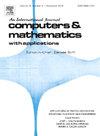Natural convection resulting from exponentially varying wall heating in a square enclosure
IF 2.5
2区 数学
Q1 MATHEMATICS, APPLIED
引用次数: 0
Abstract
The numerical investigation in this study explores the effects of non-uniform wall heating in a square cavity and its influence on natural convection behavior. A non-uniform heat source is applied to the left vertical wall of the cavity, whereas the right vertical wall is uniformly cooled. The remaining horizontal walls are thermally isolated. The main focus is on the heat transfer and fluid mixing caused by the convection occurring within the cavity. The governing equations are tackled with the help of the Dual Reciprocity Boundary Element Method (DRBEM). In the DRBEM procedure, the fundamental solution of the Laplace equation is used for solving the stream function equation, while for the vorticity transport and temperature equations-initially converted into the modified Helmholtz form-the fundamental solution of the modified Helmholtz equation (MHD) is applied. In order to transform the equations into this form, a relaxation parameter is applied to the corresponding term within the Laplace terms, and a forward difference scheme is employed for the time derivatives. In addition to the benefit of solving smaller-sized systems resulting from the boundary discretization in DRBEM, there is no requirement for an additional time integration scheme for the vorticity transport and energy equations, thus removing any potential stability issues. Calculations were performed for Rayleigh numbers of 103, 104, 105 and 106 and beta parameters . Obtained results show that the average Nusselt number was found to increase with increasing Ra and β parameter, indicating enhanced convective heat transfer. Thus, it has been concluded that the heater position is quite effective in heat transfer.
方形围护结构中由指数变化的壁面加热引起的自然对流
本文通过数值研究,探讨了方形腔内非均匀壁面加热对自然对流行为的影响。在空腔的左垂直壁上施加非均匀热源,而在右垂直壁上均匀冷却。其余的水平壁是热隔离的。主要关注的是由腔内对流引起的传热和流体混合。利用双互易边界元法(DRBEM)求解控制方程。在DRBEM过程中,流函数方程采用拉普拉斯方程的基本解,涡量输运和温度方程采用修正亥姆霍兹方程(MHD)的基本解,并初步转化为修正亥姆霍兹形式。为了将方程转化为这种形式,在拉普拉斯项的相应项上加入松弛参数,并对时间导数采用正演差分格式。DRBEM的边界离散化不仅有利于求解较小的系统,而且不需要额外的时间积分方案来求解涡度输运和能量方程,从而消除了任何潜在的稳定性问题。对瑞利数103、104、105和106以及β参数- 2、- 1、0、1、2进行了计算。结果表明,平均努塞尔数随Ra和β参数的增大而增大,表明对流换热增强。因此,可以得出结论,加热器的位置在传热中是相当有效的。
本文章由计算机程序翻译,如有差异,请以英文原文为准。
求助全文
约1分钟内获得全文
求助全文
来源期刊

Computers & Mathematics with Applications
工程技术-计算机:跨学科应用
CiteScore
5.10
自引率
10.30%
发文量
396
审稿时长
9.9 weeks
期刊介绍:
Computers & Mathematics with Applications provides a medium of exchange for those engaged in fields contributing to building successful simulations for science and engineering using Partial Differential Equations (PDEs).
 求助内容:
求助内容: 应助结果提醒方式:
应助结果提醒方式:


